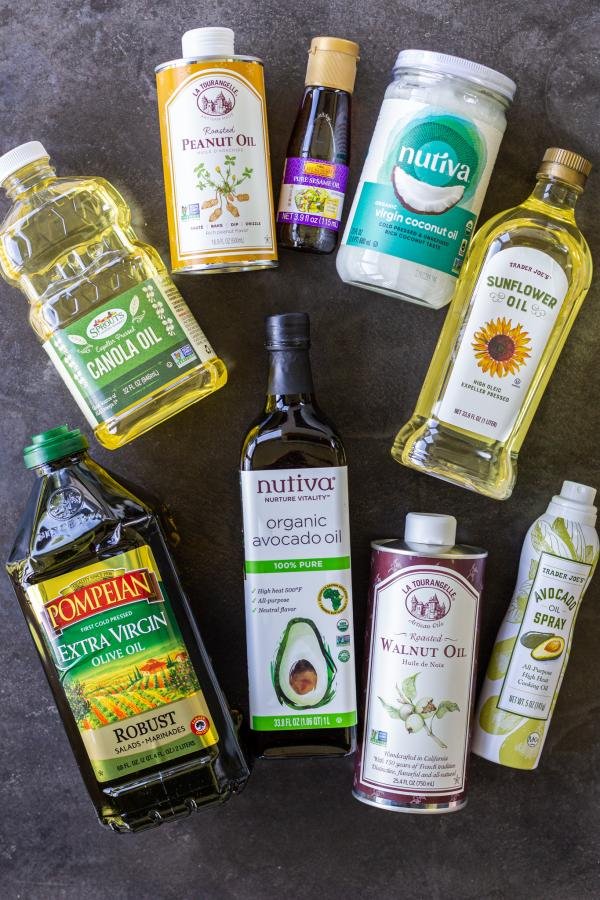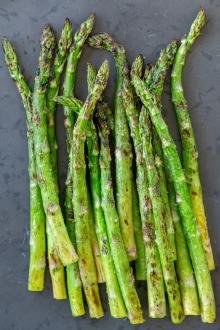This guide on cooking oil will teach you the ins & outs of every main type of oil & how to use it properly. From coconut to olive oil, we have you covered!

Have you ever stared at the cooking oil aisle in the supermarket and wondered, “What do all of these do?” You’re not alone. Oftentimes, people think cooking oils are interchangeable, but this couldn’t be further from the truth. You’ll find some oils have higher smoke points for frying, while others are best whisked into a salad dressing. In this guide, we’ll cover off on some of the most popular varieties and turn you into a cooking oil pro once and for all.
Common Kinds of Cooking Oil & When to Use Them
Here, you’ll get the 101 on the oil’s smoke point, what it’s made from, how it tastes, and where exactly you should use it. In addition, we’ve thrown in our top brand pick for each.
Avocado Cooking Oil (Momsdish Favorite)
Our Top Pick: We are huge fans of Nutiva Organic Steam-Refined Avocado Oil.
- What It’s Made From: Avocado oil is made from – you guessed it – creamy avocados. It’s packed with healthy fats and celebrated for its heart health benefits.
- How it Tastes: Avocado oil has a flavor profile that’s nutty, creamy, and grassy. More so, it tastes like an avocado, just much more mild.
- How to Use It: The neutral flavor and high smoke point of avocado oil makes it super universal in the kitchen and great for high-heat cooking. Use it for everything from roasting to salad dressing to pan frying. It’s our go-to oil for making our easy 3-ingredient oven-roasted potatoes. You’ll love how flexible the oil is across different dishes, cooking times, and heats.
Sunflower Oil
Our Top Pick: You can snag sunflower oil from any Eastern European market or off of Amazon. Trader Joe’s also has a great option.
- What It’s Made From: Sunflower oil is made from pressed sunflower seeds. It’s rich in vitamin E and vitamin K, low in saturated fat, and omega-3 fatty acids.
- How it Tastes: The flavor of sunflower oil is best described as very mild and slightly nutty. It’s not overpowering whatsoever.
- How to Use It: Sunflower oil is best used in salad dressings. Even more specifically, it’s an absolute staple in Ukrainian cooking and is used for the dressing in green cabbage cucumber salad with herbs and classic garden cucumber tomato salad. It also has a high smoke point, making it great for searing everything from poultry to fish. It’s also used for traditional Ukrainian garlic bread, aka “pampushky”.
Canola Oil
Our Top Pick: Our go-to pick for canola oil is the variety from Sprouts Market or Whole Foods.
- What It’s Made From: Canola oil is made from pressed canola seeds. It’s one of the most affordable oils on the market and is low in saturated fat and high in monounsaturated fat.
- How it Tastes: The taste of canola oil is extremely mild and nearly impossible to detect.
- How to Use It: The ultra-mild flavor of canola oil makes it wonderful for everything from baked goods to deep frying egg rolls or piroshky.
Budget Tip: If you’re going to be deep frying, canola oil is your best bet when it comes to quality and budget. If you’re already eating fried food, there’s no need to use a ton of expensive high-heat oils like avocado!
Coconut Cooking Oil
Our Top Pick: Again, we love the coconut oil at Trader Joe’s. If you don’t have one in your area, we love Nutiva Coconut Oil as well.
- What It’s Made From: Coconut oil is made in two different ways. The first method is by pressing fresh coconut meat and the other method is by pressing dried coconut meat called “copra”. When you see a label that reads “virgin coconut oil” this is oil pressed from fresh meat, while refined coconut oil is made from dried coconut meat.
- How it Tastes: Coconut oil has a slightly sweet taste to it and it adds a subtle tropical flavor to dishes.
- How to Use It: Coconut oil is best used for sautéing, stir frying, and roasting. Since it’s solid at room temperature, it’s best to not use it for things like salad dressing. It’s also a killer option for baking things like coconut macarons and coconut granola clusters.
Extra Virgin Olive Oil
Our Top Pick: This massive jug from Pompeian will last you forever. Its has a strong nutty flavor and we always have some hand.
- What It’s Made From: Extra virgin olive oil is made by pressing olives without any chemicals or heat. It’s the “creme de la creme” of olive oils.
- How it Tastes: Extra Virgin Olive Oil (EVOO) has a full-bodied flavor that is almost identical to table olives, just a touch milder.
- How to Use It: Since extra-virgin olive oil has a low smoke point, it’s best to use it for dipping bread or making salad dressing. That said, you can totally cook with it – just make sure to keep the heat of the skillet on medium-low to prevent it from burning.
An Oil to Skip All-Together: Vegetable oil is another commonly used oil, but we left it off our list for good reason. It’s typically unpredictable in flavor, high in cholesterol, and not the best tasting. Canola oil is much better, so we suggest skipping it all together!
Less Commonly Used Cooking Oil Varieties
Peanut Oil
Our Top Pick: La Tourangelle has an amazing flavored peanut oil. Good peanut oil is typically on the pricey side, but worth the splurge from time to time!
- What It’s Made From: High-quality, unrefined peanut oil is made from cold-pressed peanuts.
- How it Tastes: Peanut oil has a strong, bold nutty taste.
- How to Use It: Peanut oil is great for deep-frying, as it has a high smoke point. You’ll find it used in many Asian cuisines for frying everything from spring rolls to chicken.
Walnut Oil
Our Top Pick: Again, we love the La Tourangelle brand of walnut oil. This stuff is seriously flavorful!
- What It’s Made From: Walnut oil is made from pressed walnuts and contains a fair amount of iron, zinc, calcium and magnesium.
- How it Tastes: The flavor of walnut oil is best described in one word – bold. It’s full-flavored and a little goes a long way.
- How to Use It: Walnut oil is best used in salad dressings, pastas, or for dipping. It doesn’t do well at high temperatures and tends to taste a bit bitter when cooked. Some things are best eaten as-is and this is one of them!
Flaxseed Oil
Our Top Pick: Our go-to flaxseed oil is from Whole Foods.
- What It’s Made From: Flaxseed oil is made from pressed flaxseeds and contains so many different health benefits. From reducing inflammation to being a powerhouse of antioxidants, it’s one of the heahiest oils out there.
- How it Tastes: While flaxseed oil has a ton of health benefits, the flavor is not the best. It’s pretty bitter and a little goes a long way.
- How to Use It: Flaxseed oil is best added to recipes where it’s flavor will be masked. Add it to a green smoothie or shake or mix a little into your yogurt.
Sesame Oil
Our Top Pick: Here is a solid pick. It’s always in our pantry!
- What It’s Made From: Sesame oil is made from pressed sesame seeds and touts a ton of antioxidants.
- How it Tastes: Sesame oil has an extremely powerful nutty flavor – a little goes a very long way with this oil too.
- How to Use It: Sesame oil is used all throughout Asian cooking for everything from fried rice, stir fry, chicken lo mein, and meat marinades. You can also use it to make teriyaki-style China Coast dressing or peanut sauce.
Bonus! Cooking Oil Sprays
Cooking oil sprays are also a must-have in the kitchen. Whether you’re using your air fryer or greasing a muffin tin, they are so handy. Here’s our favorites and what we use them for:
- Chosen Foods Avocado Oil Spray – This is our all-purpose, everyday cooking oil spray for everything from stir fries to roasted potatoes. We also like the avocado spray from Trader Joe’s.
- Coconut Oil Spray – This coconut oil spray from Trader Joe’s is so good for baked goods, but this is another great brand.. The mildly sweet flavor is so on point.
How to Properly Discard Used Cooking Oil
A big no-no for cooking with oil is dumping it into the sink. As it hardens and solidifies, it can clog your pipes and cause some serious damage. To avoid this common problem, here’s how to properly toss your used cooking oil:
- Allow the Oil to Cool Down Completely: Allow the oil to cool down in the pan before attempting to handle it. Never toss hot oil – it can burn through the container you’re using and cause a big mess!
- Pour the Oil Into a Container: Pour the cooled oil into an old milk carton or the container it came in itself if you’re at the end of the bottle. Seal the carton or secure with a lid and toss the oil in the trash.
Recycling Tip: Some recycling centers will recycle used cooking oil – check with your local center to see if they accept it!
More Helpful Kitchen 101 Guides to Check Out
- How to Make Homemade Pasta – Easy DIY pasta noodles
- How to Cut Up a Whole Chicken – Breaking down a whole chicken
- Smoked Turkey – Guide for the perfect smoked turkey
- How to Bake Perfect Bacon Every Time – Crispy, mess-free bacon






Thank you for the info on the different oils. Tried to post it on my pinterest account. Wouldn't let me do it.
Hi Stacey- you're welcome. I'm sorry it wouldn't Pin for you, I just tried and it worked for me..can you try again? Maybe there was a temporary glitch.
This guide was so helpful! Thank you!!
You're welcome! 🙂
This answered SO MANY questions for me! Thank you so much!!!!
I'm glad you found it helpful, Allyson!